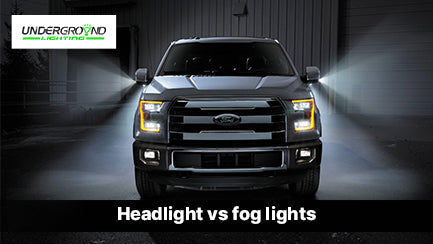Fog Lights vs Headlights: Exploring the Distinctions
When it comes to driving in challenging weather conditions, having the right set of lights can make a world of difference. We're all familiar with headlights, those trusty illuminators that guide us through the dark. But what about fog lights? Are they just an extra accessory, or do they serve a specific purpose? In this article, we'll dive into the differences between fog lights and headlights, shedding light on their unique roles and when to use them. So, buckle up and let's get started!
Headlights: Illuminating the Road Ahead
Headlights, the unsung heroes of nighttime driving, play a crucial role in ensuring our safety on the road. They are the primary lights mounted on the front of a vehicle and are designed to illuminate the roadway ahead. Whether you're driving on a pitch-black country road or navigating through a bustling city, headlights are your trusty companions, providing visibility and allowing you to spot obstacles, pedestrians, and other vehicles.
Different Types of Headlights
Not all headlights are created equal, and advancements in technology have led to various types of headlights available in the market today. Here are a few common ones:
- Halogen Headlights: These are the most commonly used headlights and have been around for decades. They produce light by passing electricity through a tungsten filament encased in a halogen gas-filled bulb. While they are cost-effective, they tend to be less efficient than newer options and have a shorter lifespan.
- LED Headlights: Light Emitting Diode (LED) headlights have gained popularity in recent years due to their energy efficiency and long lifespan. LED headlights produce light by passing an electrical current through a semiconductor. They are brighter than halogen headlights and often provide better visibility.
- HID/Xenon Headlights: High-Intensity Discharge (HID) or Xenon headlights use a combination of rare gases and an electric arc to produce light. They are known for their bright, bluish-white light and are often associated with luxury vehicles. HID headlights offer enhanced visibility and are more efficient than halogen headlights.
Fog Lights: Piercing Through the Mist
Now let's turn our attention to fog lights. As the name suggests, fog lights are designed specifically to cut through fog, mist, or other adverse weather conditions. They are typically mounted lower on the front of a vehicle, below the headlights, and provide a focused beam of light that is aimed closer to the ground.
Purpose of Fog Lights
-
Enhanced Visibility in Foggy Conditions
Fog lights have a specific purpose: to improve visibility during foggy weather. When thick fog rolls in, it can significantly reduce visibility, making it challenging to spot obstacles or other vehicles. Regular headlights can actually worsen the situation by reflecting the light off the fog and creating a blinding effect. Fog lights, on the other hand, are designed to emit a low, wide beam that illuminates the road directly in front of the vehicle, reducing glare and enhancing visibility.
-
Additional Lighting Options
While fog lights are primarily used in foggy conditions, they can also serve as an additional lighting option in other scenarios. For example, when driving on poorly lit rural roads, or in heavy rain, fog lights can help cut through the darkness and improve overall visibility. However, it's important to note that fog lights should not be used as a substitute for headlights in normal driving conditions.
Fog Lights vs Headlights
Now that we have a clear understanding of what headlights and fog lights are, let's compare them side by side to highlight their distinctive features and functionalities.
Beam Pattern and Focus
Headlights: Headlights typically have a focused beam pattern that provides long-range illumination. The light is aimed straight ahead, allowing drivers to see farther down the road.
Fog Lights: In contrast, fog lights have a wider and shorter beam pattern. The light is aimed closer to the ground, illuminating the immediate vicinity in front of the vehicle. This helps drivers see the road surface and any obstacles that may be obscured by fog or mist.
Intensity and Color of Light
Headlights: Headlights produce a bright and intense beam of light, often in a white or bluish-white color temperature. Intense light is essential for illuminating the road ahead and ensuring good visibility.
Fog Lights: Fog lights emit a softer, less intense beam of light. The light is usually yellow or amber, as these hues are less likely to reflect off fog or mist, reducing glare and enhancing visibility in adverse weather conditions.
Usage Guidelines
Headlights: Headlights are a vital component of safe driving and should be used during nighttime hours, dawn, dusk, and in any low-light situations. They are also required when visibility is reduced due to rain, snow, or other adverse weather conditions.
Fog Lights: Fog lights should only be used in foggy conditions, as they are specifically designed to cut through fog, mist, or heavy rain. It's important to turn off fog lights when visibility improves, as they can blind other drivers and create a hazard.
In conclusion, headlights and fog lights each have their unique roles and purposes when it comes to driving in challenging conditions. Headlights are the primary lights that illuminate the road ahead, while fog lights are specialized lights designed to enhance visibility in foggy or misty weather. Understanding the distinctions between these two types of lights and using them appropriately can greatly contribute to safer and more confident driving experiences. So, the next time you find yourself driving through dense fog or a torrential downpour, remember to switch on your fog lights and let them pierce through the mist, guiding your way forward.
For those looking for extraordinary lighting options, Underground Lighting stands out with its unique and customizable headlights and fog light kits. Remember, having the right lights can make all the difference when it comes to driving safely, so choose wisely and let your lights shine bright on the road ahead! Stay safe out there!

